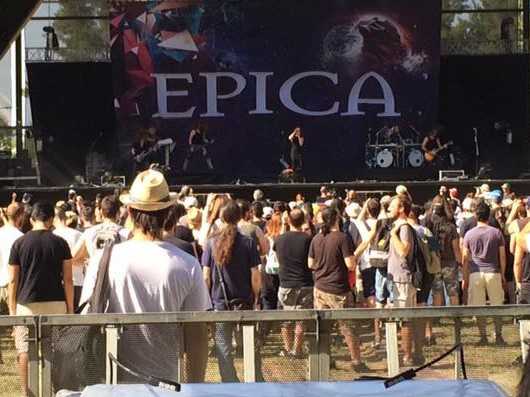ChamSys helps create new looks for Epica
- Details

Van Lokeren, who collaborates closely with two of Epica’s members Coen Janssen and Isaac Delahaye, has accentuated the band’s musical message with a ceaseless flow of compelling looks, each more unique than the next.
Helping him accomplish this feat on the group’s current Holographic Principle tour of Europe and North America is his ChamSys MagicQ MQ60 console with a compact wing.
“My constant touring life is really easy with the MQ60,” he said. “Because of the console’s compact size, it’s always possible to put my desk down to programme, on the tour bus, in the dressing room, or even on stage in change over times. I do my first drawings in Vectorworks, and then I import the DWG file into Capture, which works perfectly with my MQ60. So I can program even complicated shows in my hotel room with just my MQ60 and laptop.”
Van Lokeren values his compact console for more than the convenience it offers. As a designer, he likes to limit the number of colours he uses to light each song to two, or occasionally three. “When you have too many colours in a song, you can fall into a trap that makes the lighting for the next song look unoriginal or uninspired because you wind up repeating the same colours,” he explained.
Rather than overwhelm with a myriad of colours, Van Lokeren prefers to captivate audiences with unexpected movements that provide a visual signature for each song. Creating this effect calls for punting and pixel mapping, both of which are made easier, he says, by his Magic MQ60.
“I know I can rely on the MQ60 for punting during a show,” commented Van Lokeren. “It is a workhorse. The pixel mapping feature is great too. It makes it so easy to use. The clone/morph function saves me a lot of time, especially during festivals. For this summer run I am using 4 or 10 DMX universes, depending on if it’s a day or night show. In daylight, I have a different show file where the pixel mapping will not be used, and instead the fixtures will be run in simple mode.”
On its summer tour, Epica is appearing at a wide variety of venues from arenas, to music halls, to festival stages. “We have different stage setups because of the different venues we’re playing,” said Van Lokeren. “Each setup has a different look for the lights.”
Van Lokeren builds his current Epica rig around the Chauvet Professional Nexus Aq 5x5 RGBW pixel mapping panel, deploying 25 to 50 of them depending on the venue. “This fixture makes up most of my rig,” he said. “I use it to create a very powerful industrial robotic look, which fits the mood of the concert. The Nexus is also good for subtle colour and pattern changes, which makes the look for each song fresh and original. This sense of spontaneity has to be there in the music - and the lighting.”
(Jim Evans)
















